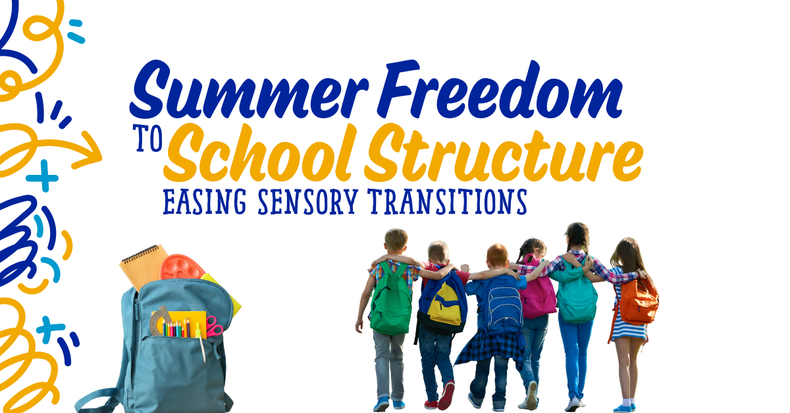The lazy days of summer are coming to an end, and for many families, the transition back to school brings excitement—and anxiety. For children with sensory processing differences, autism, or ADHD, the shift from flexible summer routines to structured classroom environments can feel overwhelming. At AdaptStore, we understand that this transition requires thoughtful preparation and the right sensory tools to set your child up for success.
Koda the Sensory Koala says: "Summer was amazing, but school can be just as wonderful with the right sensory support! Let me help you prepare for a smooth transition."

Understanding the Summer-to-School Sensory Challenge
Summer typically offers children more freedom in their sensory environment. They can move when they need to, seek quiet spaces, take breaks, and regulate their sensory systems naturally. School, however, requires sitting still, focusing for extended periods, managing noise levels, and following structured schedules—all challenging for children with sensory needs.
Common Sensory Challenges During School Transitions:
Auditory Overwhelm
-
Crowded hallways and cafeterias
-
Multiple voices and instructions
-
School bells and announcements
-
Classroom noise levels
Tactile Sensitivities
-
New school supplies and textures
-
Crowded spaces with accidental touch
-
Different clothing requirements
-
Hand sanitizer and cleaning products
Vestibular and Proprioceptive Needs
-
Extended periods of sitting still
-
Limited movement opportunities
-
Reduced outdoor play time
-
Carrying heavy backpacks
Executive Functioning Demands
-
Following multi-step directions
-
Managing time and transitions
-
Organizing materials and assignments
-
Adapting to new routines

Creating a Sensory-Smooth Transition Plan
Phase 1: Pre-School Preparation (2-3 Weeks Before)
Gradual Schedule Adjustment
Begin shifting your child's daily routine closer to school timing. If summer bedtime was 9 PM, gradually move it to 8:30 PM, then 8 PM over several nights. This helps their nervous system adapt to new rhythms without shock.
Sensory Environment Assessment
Visit the school if possible, noting potential sensory triggers:
-
How loud is the cafeteria?
-
Are the hallways crowded between classes?
-
What's the lighting like in classrooms?
-
Are there quiet spaces available for breaks?
Tool Testing at Home
Introduce potential school sensory tools during summer activities:
-
Try noise-reducing headphones during loud family gatherings
-
Practice using fidget tools during quiet activities like reading
-
Experiment with weighted lap pads during homework time
Phase 2: The First Week Back (Days 1-7)
Morning Sensory Preparation
Start each school day with sensory regulation activities:
Heavy Work Activities (5-10 minutes)
-
Wall push-ups against the bathroom wall
-
Carrying a weighted backpack around the house
-
Using a weighted neck pillow during breakfast
-
Jumping on a mini trampoline
Calming Activities
-
Deep breathing exercises with sensory breathing tools
-
Gentle joint compressions
-
Listening to calming music with comfortable headphones
After-School Decompression
Plan for sensory release after school:
-
Immediate snack and quiet time
-
Weighted blanket rest period
-
Physical movement like bike riding or playground time
-
Sensory bin play with preferred textures
Phase 3: Building Long-Term Success (Weeks 2-4)
Communication with Teachers
Share your child's sensory profile with educators:
-
Preferred sensory tools and strategies
-
Signs of sensory overload
-
Effective calming techniques
-
Movement and break needs
Consistent Sensory Diet
Establish regular sensory input throughout the school day:
-
Fidget tools for focus during lessons
-
Chewable jewelry for oral input needs
-
Compression items under clothing
-
Movement breaks with portable balance tools

Essential Back-to-School Sensory Tools
For the Classroom
Focus and Attention Tools
-
Silent fidgets: Stress balls and tactile tools that won't distract other students
-
Weighted lap pads: Provide calming pressure during desk work
-
Cushion alternatives: Sensory cushions for seating variations
-
Discrete chewables: Pencil toppers and jewelry for oral input
Organization and Executive Function Support
-
Color-coded folders and supplies
-
Visual schedules and timers
-
Sensory break cards
-
Quiet corner essentials
For Transitions and Breaks
Hallway and Cafeteria Tools
-
Noise-reducing headphones: Comfortable, adjustable options for loud environments
-
Weighted items: Small weighted stuffed animals or neck pillows for comfort
-
Movement tools: Therapy bands that can be tied to chairs
Playground and Recess Support
-
Sensory-friendly playground alternatives
-
Quiet activity options for overwhelmed days
-
Social interaction tools and games
For Home Support
After-School Recovery
-
Weighted sensory tools for immediate calming
-
Sensory swings for vestibular input
-
Comfort items: Familiar textures and preferred sensory tools
-
Decompression space: A quiet, organized area for regulation
Koda's Tip: "Remember, every child's sensory needs are different! What helps one koala might not help another, so be patient as you discover what works best for your little one."

Frequently Asked Questions
Q: How long does it typically take for a child to adjust to the school routine?
A: Most children with sensory needs require 2-6 weeks to fully adjust to new school routines. Consistent use of sensory tools and strategies can significantly reduce this adjustment period.
Q: What if my child's teacher doesn't understand sensory needs?
A: Provide educational resources about sensory processing, offer specific tool suggestions, and consider involving the school's occupational therapist or special education coordinator.
Q: Can sensory tools be distracting to other students?
A: When chosen thoughtfully, discrete sensory tools can actually improve the overall classroom environment by helping all students focus better.
Q: How do I know which sensory tools to try first?
A: Start with your child's strongest sensory preferences from home. If they seek movement, try balance tools. If they need calming input, begin with weighted items.
Your Sensory Transition Toolkit
As you prepare for another school year, remember that successful transitions happen gradually, with patience, and with the right sensory support tools. Every child's sensory system is unique, and finding the right combination of strategies and tools may take time.
At AdaptStore, we're here to support your family's sensory journey with high-quality, therapeutic-grade tools designed by occupational therapy professionals. From weighted comfort items to discrete classroom fidgets, we provide the sensory support that helps children thrive in school environments.
Ready to create a sensory-successful school year? Browse our Sensory Collection or contact our team for personalized recommendations. With free shipping over $99 and free Friday pickup in Edmonton, getting the right sensory support for your child has never been easier.
Koda says: "Here's to a fantastic school year filled with learning, growth, and plenty of sensory success! You've got this!"
Have questions about choosing the right sensory tools for your child's school transition? Contact AdaptStore at ecommerce@adaptabilities.ca or visit our Contact Form personalized support from our sensory specialists.


